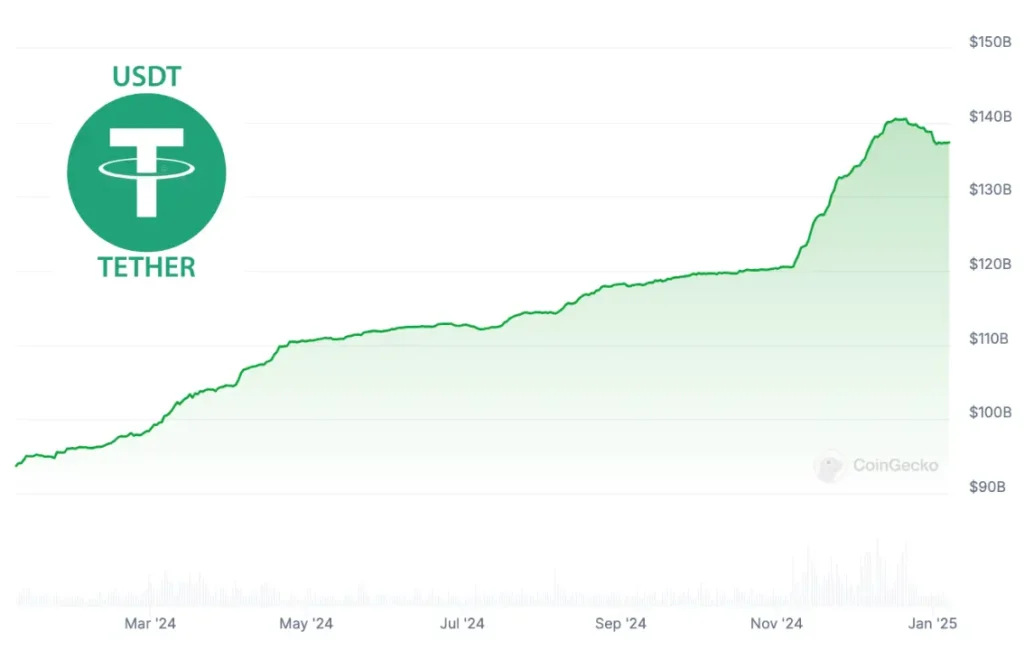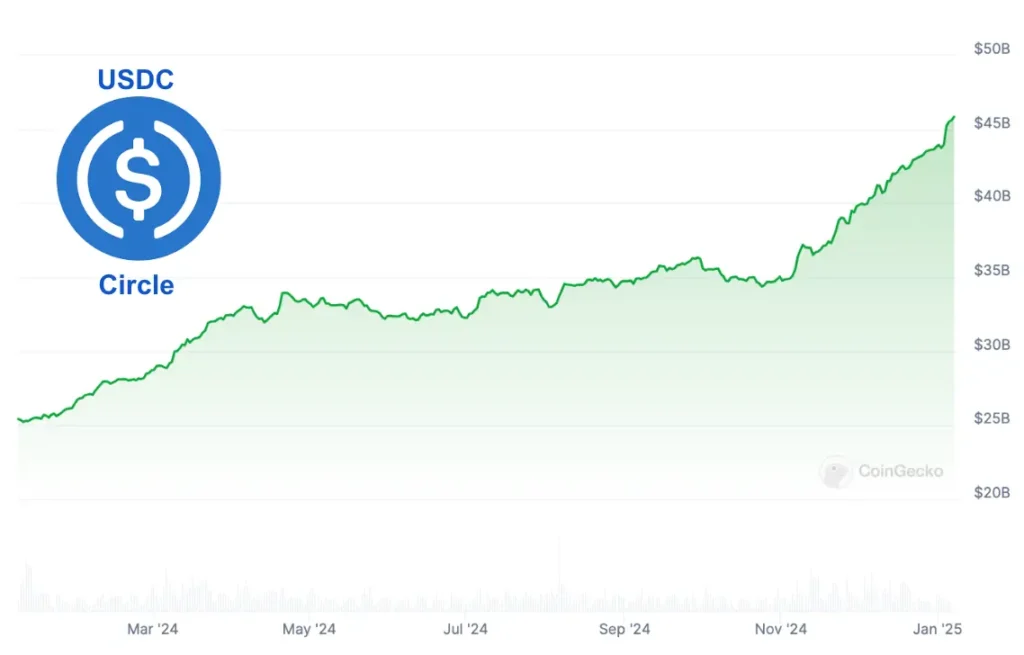In addition to rapidly growing usage, the quantity of stablecoins in circulation also grew rapidly in 2024, with a total of $203 billion at December 31, 2024, up from $131 billion a year earlier.
What are the biggest stablecoins?
The top rankings have changed little, with each stablecoin experiencing significant growth in mass in circulation, except for DAI, which is gradually being replaced by USDS.

Number 1
- USDT of Tether, with $137 billion in capitalization at 12/31/24, compared with $90 billion a year earlier.

Number 2
- Circle’s USDC, with 43 bn, compared with 25 bn a year earlier.

USDC de Circle, with 43 bn, compared with 25 bn a year earlier.
Number 3
- USDS, an improved version of DAI, launched by SKY (formerly MakerDAO) on October 26, with 5.9 bn capitalization at launch.
Number 4
- USDe from Ethena, with 5.8 billion, launched on January 6, 2024.
Number 5
- DAI, with 3.4 billion versus 5.3 billion a year earlier (gradually replaced by USDS).
Other stablecoins created in 2024 are gradually making their way onto the market.
Exceptional momentum is building on Usual’s USD0. Launched on August 28 with an initial mass of 203 million USD0 in circulation, it had already reached 1.7 Billion dollars by January 1, 2025!
The Usual protocol is headed by Pierre Person, a former French MP from 2017 to 2022, who was a driving force behind France’s adoption of regulations framing digital asset finance activities. Pierre Person is now involved in the development of USD0, a stablecoin backed by real-world assets (“Real World Assets backed stablecoin”), and which promises to redistribute to its holders the income generated by the assets held as collateral.
Other highlights of the year
- The acceleration of the PYUSD by Paypal, which reached a capitalization of $460 million, compared with $217 million a year earlier, even though it peaked at $1.04 billion in August before falling back since,
- The launch of BUIDL, Blackrock’s stablecoin, which is a token with a value of $1. It differs somewhat from other stablecoins in that it is a unit of a tokenized bond fund, each unit worth $1, which generates a return from US Treasury bonds. It is not designed to be traded as a “currency” like other traditional stablecoins.

- Tether, the USDT issuer, has announced that its EURT stablecoin, which is not MiCA-compliant, will be discontinued by the end of 2025. Although it now intends to support EURQ, a MiCA-compliant stablecoin issued by its partner Quantoz, which uses Tether’s technology. Tether considers that European regulations put stablecoins at risk by exposing them to traditional banks, preferring to place its collateral funds directly in US Treasury bonds mainly, and to a lesser extent other assets not dependent on bank solvency (Gold, Bitcoin…).
- Aave’s GHO increased from 33 to 157 million in one year, driven by the protocol’s momentum.
- Inverse Finance’s DOLA has risen from 36 to 152 million in one year.
- On December 17, the American company Ripple launched its own stablecoin, the RLUSD, with a capitalization of $72 million.
What movements to watch out for in the coming months?
Interestingly, MiCA-compliant USDC has been gaining market share on USDT for the past two months. While USDC represented around 30% of USDT’s market cap for much of the year – with both stablecoins growing at the same rate – a gap has been opening up in recent weeks in favour of USDC. The latter saw its capitalization rise by 14% in one month to $45.9 billion on January 7, 2025, while USDT’s capitalization fell by 0.30% over the same period to $137.5 billion on January 7, 2025. The USDC now represents 33.40% of the USDT’s capitalization. These are perhaps the first noticeable effects of MiCA’s entry into force, which favours USDC against its competitor USDT, which has chosen not to comply with European regulations. The coming months will tell us whether the rebalancing continues, or whether USDT remains ultra-dominant.
The USD0 will also be one to watch. Its impressive momentum since launch suggests that it could quickly become a major stablecoin.
As far as Euro stablecoins are concerned, it has to be said that momentum is slow to build. MiCA regulations, which came into force on January 1, 2025, following a first step on June 30, 2024 for stablecoins, now offer a clear framework that should encourage their adoption. We believe the spark will soon be lit for Euro stablecoins, as they meet a real need as part of the institutionalization of the sector. It will be interesting to monitor their capitalization and trading volumes over the coming months…

